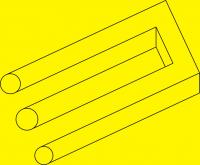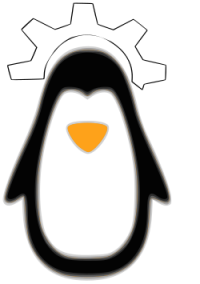Manual or Tutorials to get started using EMC2
- Chipmunk
- Offline
- Junior Member
-

- Posts: 34
- Thank you received: 0
Idle Chipmunk
Please Log in or Create an account to join the conversation.
- cncbasher
- Offline
- Moderator
-

- Posts: 1744
- Thank you received: 288
a good book for explaination of gcode etc is ' CNC PROGRAMMING HANDBOOK ' by Peter Smid , i believe it's up to revision 3 at the moment .
search the internet and you'll soon find it .
touch off is the setting of the work zero points which is usualy for argument the corner of x & y axis and the top surface of the work for the z
G54 is the relation of machine zero references and the touch off points or work zero , they of course can be the same if you wish , machine zero is the point at which your machine is homed and ready for use
machine zero is a fixed point , where work zero can be just about anywhere you wish within the cutting envelope and your gcode references to it
wiki.linuxcnc.org/cgi-bin/wiki.pl?CoordinateSystems
Please Log in or Create an account to join the conversation.
- Rick G
-

- Offline
- Junior Member
-

- Posts: 26
- Thank you received: 155
Please Log in or Create an account to join the conversation.
- Chipmunk
- Offline
- Junior Member
-

- Posts: 34
- Thank you received: 0
I will see if I can find the book.
Please Log in or Create an account to join the conversation.
- Chipmunk
- Offline
- Junior Member
-

- Posts: 34
- Thank you received: 0
I will have a look at the Sherline site. I had not done that as my machine is a Taig.
Please Log in or Create an account to join the conversation.
- arch dude
- Offline
- Junior Member
-

- Posts: 26
- Thank you received: 1
Here is the fundamental fact you really need to understand:
The default coordinate system is G54
Repeat:
The default coordinate system is G54
This is hidden in a bunch of clutter in the documentation. In particular, until I edited the wiki this evening, G54 was not distinguished from the other workpiece coordinate systems until quite late in the document.
Basically: G53 is the machine-relative coordinate system, G54 is the workpiece-relative system. If you use a CAD program and then a CAM program to produce G code, the G code will be in the workpiece-relative coordinate system. It is quite practical to always operate in this system and never leave it.
G54 is handled as a special system in several places. Most notably, the "touch off" sets the G54 origin.
OK, then. Why are there other coordinate systems?
G53 is needed to set the actual physical limits for the machine and to identify any special locations, such as the tool change location.
G55 ... G59, and G59.1 ... G59.3 can be used for sub-pieces within the workpiece. I suppose a CAD/CAJM toolchain might use these. Not sure why.
G92 is used to shift the entire set of workpiece systems to a different origin. This is useful if you have several identical workpieces on your machine at the same time.
G43 is used to shift the entire set of workpiece systems up or down to accomodate a longer or shorter tool when you do a tool change.
For a beginner with a simple task and a single workpiece, G55... G59.3 are not used, because there are no sub-pieces. G92 is not used, because there is only one workpiece. G43 IS used, but only if you are using more than one tool on your job. G53 is used to set up physical limits.
Given that I only learned this yesterday, I may not have it all correct.
Please Log in or Create an account to join the conversation.
- Chipmunk
- Offline
- Junior Member
-

- Posts: 34
- Thank you received: 0
Chipmunk, getting closer to making chips.
Please Log in or Create an account to join the conversation.
- Rick G
-

- Offline
- Junior Member
-

- Posts: 26
- Thank you received: 155
getting closer to making chips
Well that is what it is all about. The Sherline info may be somewhat dated but the concepts are the same.
After you have gone over the all the info let us know if you found it helpfull.
Good luck,
Rick G
Please Log in or Create an account to join the conversation.
- BigJohnT
-

- Offline
- Administrator
-

- Posts: 7000
- Thank you received: 1175
G55 ... G59, and G59.1 ... G59.3 can be used for sub-pieces within the workpiece. I suppose a CAD/CAJM toolchain might use these. Not sure why.
G92 is used to shift the entire set of workpiece systems to a different origin. This is useful if you have several identical workpieces on your machine at the same time.
G43 is used to shift the entire set of workpiece systems up or down to accommodate a longer or shorter tool when you do a tool change.
For a beginner with a simple task and a single workpiece, G55... G59.3 are not used, because there are no sub-pieces. G92 is not used, because there is only one workpiece. G43 IS used, but only if you are using more than one tool on your job. G53 is used to set up physical limits.
Given that I only learned this yesterday, I may not have it all correct.
For a single vise I set the G54 offset so that the front of the back jaw is Y0.000 and the left or right side of the material is set to X what ever makes sense for the G code program and Z0.000 to the top of the material with my tool. If you have a tool changer and all the tools are touched off in Z to some common point then all the tools will now be offset properly for the material in the vise.
G55-G59.3 are sometimes refereed to as "fixture offsets" ie if you had 2 vises with stops for the material you would machine one part in G54 and one part in the second vise with the same G code just by using G55... of course you would have to set the G55 coordinate system to the second vise first.
I use G92 on my plasma cutter with every cut to set the XYZ zero point to where I have jogged the torch to.
If you have repeatable tools and by this I mean you can touch off the Z of a tool take it out and put it back and the Z is still the same so this excludes any collet type of tool holder that the collet is in the spindle. When you change tools with Tn M6 you use G43 to load that tools offset.
John
Please Log in or Create an account to join the conversation.
- eFalegname
-

- Offline
- Elite Member
-

- Posts: 253
- Thank you received: 30
For a single vise I set the G54 offset so that the front of the back jaw is Y0.000 and the left or right side of the material is set to X what ever makes sense for the G code program and Z0.000 to the top of the material with my tool. If you have a tool changer and all the tools are touched off in Z to some common point then all the tools will now be offset properly for the material in the vise.
G55-G59.3 are sometimes refereed to as "fixture offsets" ie if you had 2 vises with stops for the material you would machine one part in G54 and one part in the second vise with the same G code just by using G55... of course you would have to set the G55 coordinate system to the second vise first.
I use G92 on my plasma cutter with every cut to set the XYZ zero point to where I have jogged the torch to.
If you have repeatable tools and by this I mean you can touch off the Z of a tool take it out and put it back and the Z is still the same so this excludes any collet type of tool holder that the collet is in the spindle. When you change tools with Tn M6 you use G43 to load that tools offset.
John
Hi,
I divided my table in areas and work using all of the fixture offsets on LinuxCNC, my question is: is there a way that LinuxCNC (M2) does not restore G54 at the end of each program so I can put a pyvcp button or spinbox that keeps active the fixture offset I want to?
Thanks
Please Log in or Create an account to join the conversation.
